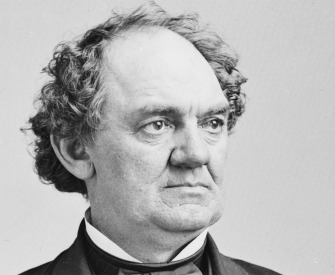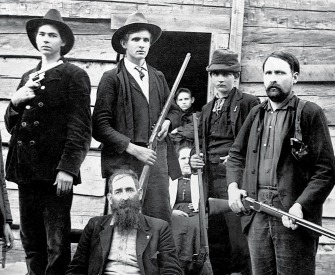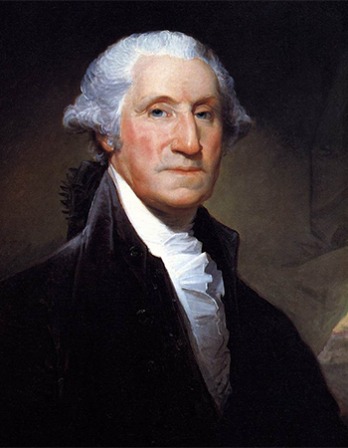What is food to one is to others bitter poison.
—Lucretius, 50 BCPastoral Romance
The exalted status of the American farmer has long been removed from reality of feeding a nation.
By Brent Cunningham
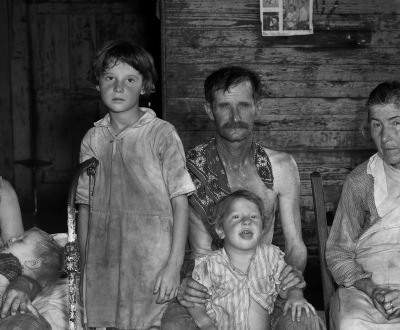
Sharecropper’s family, Hale County, Alabama, 1935. Photograph by Walker Evans.
Betty Jo Patton spent her childhood on a 240-acre farm in Mason County, West Virginia, in the 1930s. Her family raised what it ate, from tomatoes to turkeys, pears to pigs. They picked, plucked, slaughtered, butchered, cured, canned, preserved, and rendered. They drew water from a well, cooked on a wood stove, and the bathroom was an outhouse.
Phoebe Patton Randolph, Betty Jo’s thirty-two-year-old granddaughter, has a dream of returning to the farm, which has been in the family since 1863 and is an hour’s drive from her home in the suburbs of Huntington, a city of nearly fifty thousand people along the Ohio River. Phoebe is an architect and a mother of one (soon to be two) boys, who is deeply involved in efforts to revitalize Huntington, a moribund Rust Belt community unsure of what can replace the defunct factories that drove its economy for a hundred years. She grew up with stories of life on the farm as she watched the empty farmhouse sag into disrepair.
Recently, over lunch in Betty Jo’s cozy house in a quiet Huntington neighborhood, I listened to them talk about the farm, and I eventually asked Betty Jo what she thought of her granddaughter’s notion of returning to the land. Betty Jo smiled, but was blunt: “Leave it. There’s nothing romantic about it.”
Leave it? But isn’t Green Acres the place to be? Listening to the conversation about food reform that has unspooled in this country over the last decade, it’s hard to avoid the idea that in terms of food production and consumption, we once had it right—before industrialization and then globalization sullied our Eden. Nostalgia glistens on that conversation like dew on an heirloom tomato: the belief that in a not-so-distant past, families routinely sat down to happy meals whipped up from scratch by mom or grandma. That in the 1950s, housewives had to be tricked by Madison Avenue marketers into abandoning beloved family recipes in favor of new Betty Crocker cake mixes. That the family farm was at the center of an ennobling way of life.
Evidence of the nostalgia abounds. There is an endless series of books by urban food revolutionaries who flee the professional world for the simple pleasures of rural life, if only for a year or so: Growing A Farmer: How I Learned to Live Off the Land; Coop: A Family, a Farm, and the Pursuit of One Good Egg; The Bucolic Plague: How Two Manhattanites Became Gentlemen Farmers: An Unconventional Memoir. A new crop sprouts each year. There’s Michael Pollan’s admonition, in his bestselling book Food Rules, to not “eat anything your great-grandmother wouldn’t recognize as food.” And then there are countless articles about the young and educated putting off grad school to become organic farmers. A March 5 piece in the New York Times is typical. Under the headline, “In New Food Culture, a Young Generation of Farmers Emerges,” it delivers a predictable blend: twenty-somethings who quit engineering jobs to farm in Corvallis, Oregon—microbrews, Subarus, multiple piercings, indie rock, yoga. This back-to-the-landism is of a piece with the nineteenth-century, do-it-yourself fever that has swept certain neighborhoods of Brooklyn, complete with handlebar mustaches, jodhpur boots, classic cocktails, soda shops, and restaurants with wagon wheels on the walls.
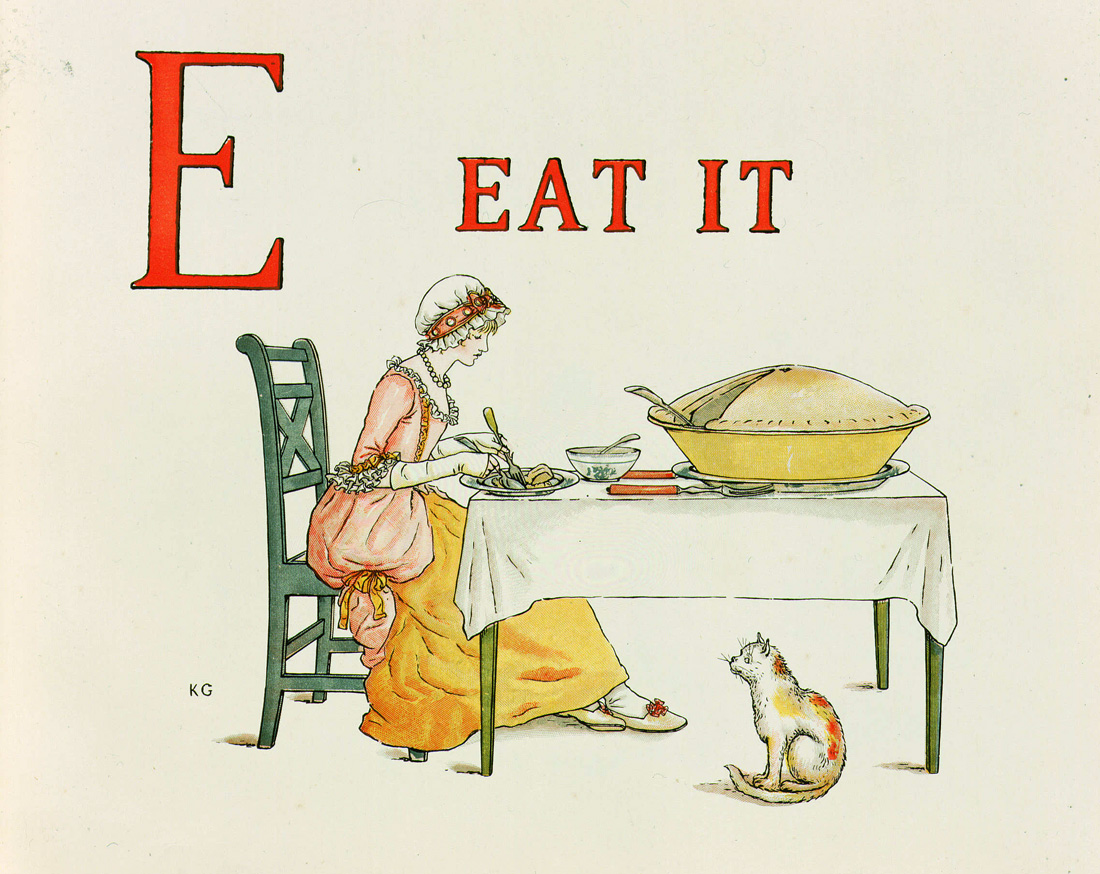
Illustration from Kate Greenaway’s Alphabet, 1885.
The surest sign that this nostalgia has reached a critical mass, though, is that food companies have begun to board the retro bus. PepsiCo now has throwback cans for Pepsi (the red-white-and-blue one Cindy Crawford famously guzzled in the 1990s) and Mountain Dew (featuring a cartoon hillbilly from the 1960s) in which they’ve replaced “bad” high-fructose corn syrup with “good” cane sugar. Frito-Lay is resurrecting a Doritos chip from the 1980s (taco-flavored, a sombrero on the package). When nostalgia is co-opted by corporate America and sold back to us, as it invariably is, the backlash can’t be far behind. Consider this the opening salvo.
It’s unlikely that most serious food reformers think America can or should dismantle our industrial food system and return to an agrarian way of life. But the idea that “Food used to be better” so pervades the rhetoric about what ails our modern food system that it is hard not to conclude that rolling back the clock would provide at least some of the answers. The trouble is, it wouldn’t. And even if it would, the prospect of a return to Green Acres just isn’t very appealing to a lot of people who know what life there is really like.
I came to Huntington last November with my wife, the food writer Jane Black, to research a book about the effort to build a healthier food culture there. This is where celebrity chef Jamie Oliver last year debuted his reality television show, Jamie Oliver’s Food Revolution, after the Huntington metro area was labeled the nation’s most unhealthy community by a 2008 Centers for Disease Control study. It is a place that has suffered the familiar litany of postindustrial woes: a decimated manufacturing base, a shrinking population, a drug problem. It is also precisely the kind of place where the food-reform movement must take hold if it is to deliver on its promise of large-scale and enduring change.
How would the messages and assumptions that have powered the movement in the elite enclaves where it took root over the last decade—like Brooklyn, where we live, Berkeley, Washington, DC, etc.—play in communities like Huntington? Places where most people don’t consider Applebee’s and Wal-Mart to be the enemy. Where the familiar and the consistent are valued over the new and the exotic, especially when it comes to what’s for dinner. Where a significant portion of the population lives in poverty or perilously close to it.
Jane and I suspected that the environmental, social justice, it-just-tastes-better case for eating seasonally and sustainably that our foodie friends consider self-evident would be met with skepticism—or shrugs—by people who have more pressing concerns than the plight of tomato pickers in Florida or the fact that cows are meant to eat grass, not corn. Nostalgia, though, did not immediately register with us as part of the movement’s message problem. Perhaps because we live in the same world as the people who write those My-Year-Doing-X books, foodie nostalgia only seemed an innocuous, if annoying, bit of yuppie indulgence.
But in Huntington we kept meeting people like Betty Jo. Alma Keeney, for instance, who also grew up on a farm, is baffled by her daughter-in-law Shelly’s decision to launch a goat-cheese business. Shelly runs the fledgling Yellow Goat Farm with her friend, Dominique Wong, and together they tend their Nubian and Alpine dairy goats on a small plot in Proctorville, Ohio, just across the river from Huntington. The eighty-seven-year-old Alma, Shelley told us, prefers individually wrapped American slices of cheese, not “farm food,” which brings back memories of hard times. Jane and I started thinking about the uncritical, even simplistic way that our agricultural past—and our kitchen-table past—are referenced in American society generally, and in the conversation about food reform specifically.
The farmer is among the most enduring figures in the American pantheon. “Those who labor in the earth are the chosen people of God,” wrote Thomas Jefferson in Notes on the State of Virginia, his classic work on the promise of the American experiment. The agrarian ideal—a belief that the family farm is the soul of the nation, a pure embodiment of our democracy—is a recurring theme in the national narrative. In 1782,
J. Hector St. John de Crèvecoeur, in his Letters from an American Farmer, celebrated the notion of independence and self-sufficiency that is central to the story: “Where is that station which can confer a more substantial system of felicity than that of an American farmer, possessing freedom of action, freedom of thoughts, ruled by a mode of government which requires but little from us?”
The exalted status of the farmer has influenced political strategy and policy decisions throughout our history: in New Deal legislation that sought to place the family farm, which struggled mightily during the Depression, on par with other industries primarily through price supports; in an amendment to the Selective Service Act of 1940, which granted deferments to young men who were “necessary to and regularly engaged in an agricultural occupation”; in the creation of the U.S. food-assistance program in 1954, which pitted the stalwart American farmer against the menace of Soviet collectivized agriculture. And it surely informs the nostalgia that shrouds today’s food-reform movement. One can essentially trace a through line from Thomas Jefferson’s romantic image of the farmer to a recent defense of rural America in the Washington Post by Tom Vilsack, the U.S. Secretary of Agriculture: “There’s a value system there. Service is important for rural folks. Country is important, patriotism is important.”
Today most of us are so removed from the agricultural life, and so ignorant about its realities, that this wholesome and nostalgic lens is the only one we know. Research by the FrameWorks Institute, a think tank employed by nonprofits to strategically reframe public conversation about social issues, found that for Americans, “Rural Utopia” is the dominant image of life beyond the cities and suburbs: a countryside “filled with poor but noble, tough and hard-working people living healthier and fundamentally better lives than the rest of us.” This despite the fact that the reality in rural America today is one of decline: unemployment, rising divorce rates, a scramble to get out. According to the Bureau of Labor Statistics, farming is the nation’s fourth-most-dangerous job.
Still, nostalgia has been a useful tool for the food-reform movement. It has provided a blueprint for how to think about and act on the daunting environmental, moral, and health problems associated with our industrial food-system for people who have the resources—financial, social, and educational—that allow them to participate in the movement if they so choose, and that predispose them to be sympathetic to the cause in the first place. Whether they started raising chickens in their backyards or simply became better informed about how their food is produced, this idea that we’ve lost our way has helped make food important, and in ways that go beyond simple sustenance.

The Decadence of the Romans, by Thomas Couture, 1847. Musée d'Orsay, Paris.
Most of these food revolutionaries won’t become actual farmers, and most of those who do—including those microbrew-swilling kids in Corvallis—won’t make a career of it. But the movement has, I suspect, permanently changed their attitudes toward food, and this alone is already forcing modest systemic change. Since 1994 the number of farmers’ markets in the U.S. has risen from 1,700 to more than 6,000. And between 2000 and 2009, organic-food sales grew from $6 billion to nearly $25 billion—still less than 4 percent of total U.S. food sales, but it’s a start. Twenty years from now, most of these young “farmers” will have rejoined the professional ranks. Like their middle-class forefathers who tuned in, turned on, and dropped out in the 1960s, the appeal of financial security and a climate-controlled office will, in most cases, win out. That said, they probably won’t be regulars at McDonald’s, and they’ll instill these values in their own kids.
Nevertheless, a “bourgeois nostalgia” pervades the food-reform movement, as Amy Trubek, an anthropologist at the University of Vermont who studies food and culture, points out. This is a perception of our food history that is the luxury of people who have little or no experience with farming, or more generally with manual labor. A perception that appeals to those who have never had to cook from scratch, let alone milk cows, kill chickens, and bake bread, just to get food on the table every day. A perception of people for whom it makes perfect sense to redefine their leisure time to include things like making guanciale or Meyer-lemon marmalade. As such, it may not resonate with great swaths of the public who don’t fit this demographic profile, and it is a perception that ignores some crucial truths about our food history.
The reality of America’s food past is far more complicated, and troubling, than is suggested by the romantic image at the heart of our foodie nostalgia. In Revolution at the Table and its sequel, Paradox of Plenty, the historian Harvey Levenstein provides a more sober, and ultimately more useful, accounting of that past. Levenstein shows how, starting in the late nineteenth century and continuing through the twentieth, food preparation steadily migrated outside the home. The reason is simple: if you have no choice but to plan and prepare multiple meals every day, cooking not only isn’t cool, it’s tedious and damned hard work.
Jane and I experienced this firsthand in West Virginia. We both are skilled and enthusiastic cooks, and as part of the reporting for the book, we wanted to see how well, and local, we could eat, and for how much money, preparing three meals a day. But we also understood that we were the kind of people for whom cooking is a hobby. Outside our door in Brooklyn, there is a cornucopia of options for the nights when we are busy or not in the mood to cook. In Huntington, though, most of those options are missing. Three months in we began to notice, with dismay, that as soon as one meal was finished, we had to start thinking about the next. Four months in, the joy of cooking was replaced by a growing irritation, a longing to amble down the block for banh mi or a bowl of ramen. By mid-March, Jane wrote in her journal, “Officially sick of cooking.”
Between 1880 and 1930, the fruits of industrialization—canning, bottling, the growth of food manufacturers and restaurants—enabled the outsourcing of food preparation that Levenstein describes. Improved transportation—first the railroad and then the automobile—and food-preservation processes—refrigerated rail cars, for instance—brought an end to seasonal and regional restrictions on what we ate. Soon, people in Kentucky had the same food choices as those in New York or California.
It is not from the benevolence of the butcher, the brewer, or the baker that we expect our dinner, but from their regard for their own interest.
—Adam Smith, 1776The standardization of the American diet, so bemoaned by people like me, is what many—maybe even most—people want at mealtime. It is reassuring to have what everyone else has. The desire to have the same Big Mac in Syracuse as in San Diego is a big part of why fast-food outlets became America’s default dining-out option, and why suggesting that as a nation we return to a more seasonal and regional way of eating will be a tough sell.
The family farm itself was not immune to these developments. By the 1920s and ’30s, the gap between city and farm diets had begun to collapse, as processed foods became high-status items in rural areas. Poor Appalachian farmers began to prefer canned hams to country hams; farm women who could afford store-bought canned vegetables and other processed food embraced this new convenience without a second thought that they were abandoning a purer, nobler way of life.
There’s a reason that less than 2 percent of people in this country are engaged in farming today, and it isn’t simply that they’ve been driven off the land by Cargill and ADM. Just like Betty Jo Patton, many of them wanted things to be easier. This revolution at the table—the one that produced the food culture that today’s revolutionaries are trying to counter—was considered a tremendous leap forward. It was modern. It gave people time for things other than keeping the family fed.
There is an even more fundamental concern about our nostalgia: America’s food system has always depended on the exploitation of someone, whether it was indentured servants, slaves, tenant farmers, braceros and other guest workers, or, now, immigrants. In his ode to the American farmer, Crèvecoeur made it clear that he had a little help on his farm. “My Negroes are tolerably faithful and healthy,” he wrote. This is an aspect of our agricultural heritage that rarely gets mentioned in the mainstream conversation about food-system reform, and it raises thorny questions about who actually grows, harvests, processes, and prepares the food in a capitalist society. We have no history of a food system that does not depend on oppression of some sort, and it seems unlikely that we will be able to create a future system that avoids this fate. The leaders of the food revolution have, in recent years, begun to speak out on the matter of farm-worker rights. But few acknowledge—at least in the public debate—that if a central goal of the movement is a more equitable food system, then the notion that we once had it right is deeply problematic.
Exploitation is as true in the kitchen as in the field. Women have always borne the burden of transforming the raw to the cooked in the American home. Interestingly, it was a confluence of these two inconvenient truths about our food past—its reliance on women and exploited labor—that helped set the stage for our national embrace of fast food.
During the Gilded Age following the end of the Civil War, and continuing into the early twentieth century, America’s rapidly expanding ranks of wealthy industrialists used extravagant dinner parties, featuring French haute cuisine, as a way to showcase their status. Hosts and hostesses sought to outdo one another: chefs were imported from France; eight courses were standard, as were menu cards, elaborate centerpieces, and a labor-intensive style of service known as à la Russe, which involved a butler carving and arranging the food on plates at a sideboard, which were then delivered to guests by servants. (The traditional style had been to fill the table with platters and bowls and let the guests serve themselves.)
The fetish for French cuisine, and all the attendant showmanship, quickly trickled down, and the nation’s middle-class, which also was expanding, sought pecuniary emulation of this conspicuous consumption. Competitive dinner parties became a fixture of middle-class social life. And it wasn’t just at dinner; there were also multicourse luncheons and high teas to pull together. The problem, though, was that middle-class households couldn’t afford the number and quality of servants necessary for this kind of entertaining. This “servant problem,” as Levenstein calls it, became something of an obsession for American housewives, who saw it as the main obstacle to fulfilling society’s expectations of them.

Deer hunt, from the Devonshire Hunting Tapestries, Netherlands, c. 1445. Victoria and Albert Museum, London.
Their plight led to various time-saving experiments, including cooperative kitchens—in which meals for multiple families were prepared for pickup in a central location—and the first home-meal delivery services. The former failed because they were regarded as a violation of the “ideal of American family life,” a critique that had more than a whiff of antisocialist sentiment. The latter, it turns out, was simply an idea ahead of its time. These delivery services conformed to what was then considered the standard for a “proper meal”: three courses and a menu that changed daily. As such, they were too expensive to be sustainable. The inability to solve the middle-class servant problem led, eventually, to a new conception in American society of what constituted a proper meal: simpler, cheaper, and of course, faster. We know how that story turned out.
By misrepresenting—or misunderstanding—our food history, we make a realistic conversation about what to change and how to change it more difficult than it already is. America will not revert to a nation of family farms. Convenience will always be important. Seasonal and regional limitations on what we eat can only go so far. If Americans want to cook like their grandmothers, fine, but the fact is our grandmothers, by and large, made only a handful of meals, they made them over and over again, and they used plenty of shortcuts, courtesy of the industrial age. My grandmother’s cornbread, which still remains the gold standard for cornbread in my family twenty years after her death, began with a Martha White mix.
Nostalgia is part of a larger message problem that food revolutionaries face as they attempt to broaden the appeal of their cause. For example, when Wal-Mart announced earlier this year that it would, over the next five years, reduce the amount of sodium by 25 percent and added sugars by 10 percent in its house brands, and pressure other food manufacturers whose products it carries to follow suit, the overwhelming response from within the food-reform community was, “That’s not good enough.”
In Huntington, and in communities across the country, Wal-Mart is where a lot of people get their food. They like the way the food there tastes. If that food has less sugar and salt—incrementally less so that they will still like the way it tastes—that is an important, and realistic, step toward a healthier food culture. Wal-Mart has many bad policies, but it’s shortsighted to write off every initiative just because it comes from Wal-Mart. New ideas about food need to conform to people’s social and economic aspirations, and those aspirations are going to be different in 2011 than they were in 1900, and they will be different, too, in Huntington, West Virginia, than in Brooklyn, New York. Achieving fundamental and lasting change in our food system will require the efforts of those yuppie farmers in Oregon who can afford to step outside the mainstream food culture and, as they say, vote with their forks. It will also require the more hard-won, incremental reforms at the big food processors and sellers, like Wal-Mart, that feed the great mass of people who either can’t or won’t vote with their forks.
Somewhere in the middle of these two efforts, hopefully, we can eventually arrive at a food system that makes sense for the twenty-first century. But the process of figuring out what that will look like needs to begin with a full and honest accounting of where we’ve been, and what’s possible given where we are.
